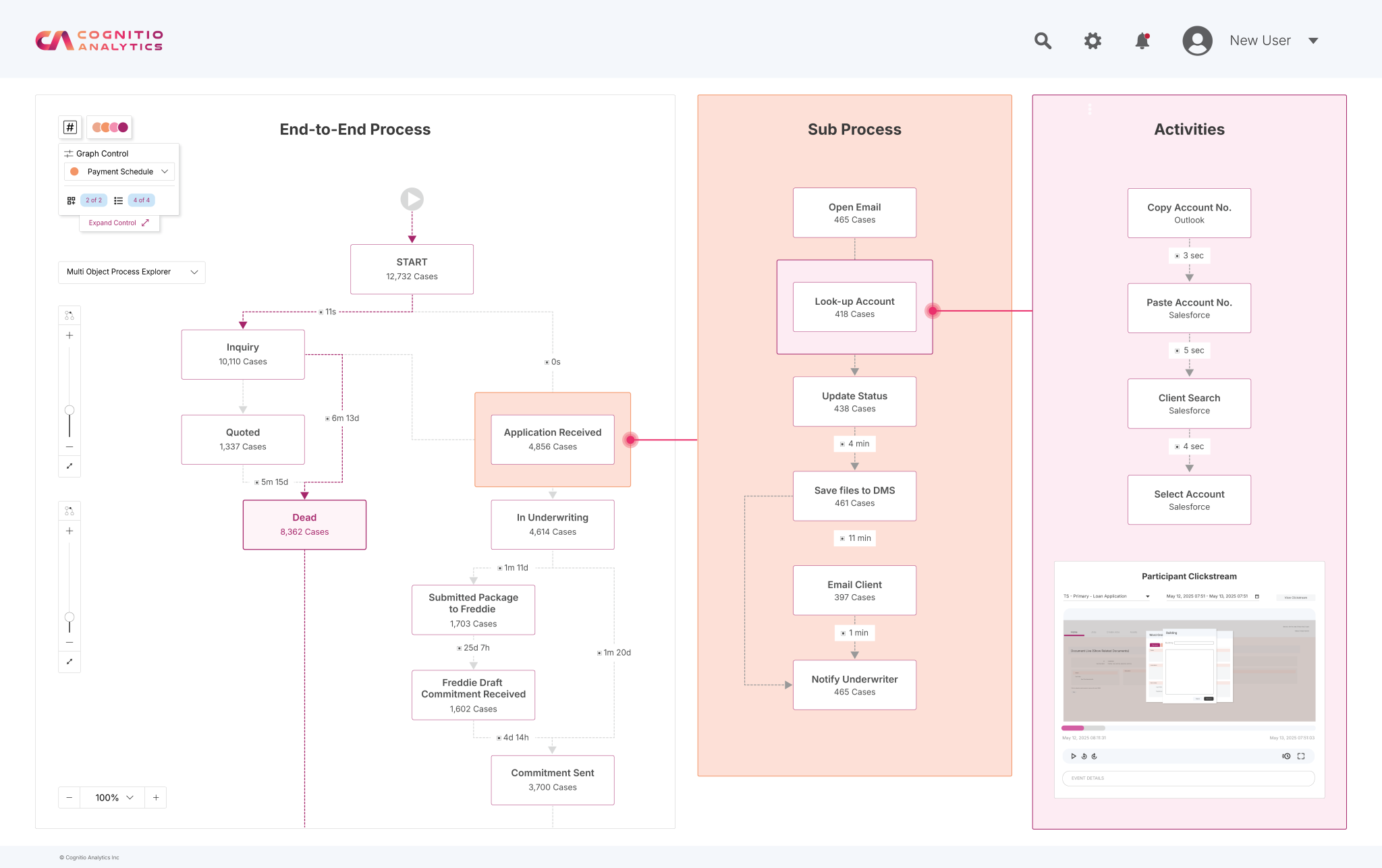
Choosing the Right Lens: Process or Task Mining or Both
- Published Date: August 26, 2025
In the quest for operational excellence, the modern enterprise has an unprecedented arsenal of analytical tools. For Cognitio Analytics and our clients, two of the most powerful are process mining and task mining. While both are critical components of a comprehensive combined process intelligence strategy, knowing when to use each, or when to combine them, is key to maximizing your return on investment.
Process vs. Task Mining: A Tale of Two Perspectives
Understanding the fundamental difference between these two technologies is the first step in building a successful strategy.
- Process Mining provides a high-altitude, end-to-end view of your operations. It uses system-generated event logs to map the actual flow of work across departments and systems. This is the big picture, revealing bottlenecks, deviations, and compliance issues at a macro level. Think of it as a satellite view of a city, showing traffic patterns and major road closures.
- Task Mining offers a boots-on-the-ground perspective. It captures desktop-level user interactions (clicks, keystrokes) to understand how individual tasks are performed. This granular data reveals hidden inefficiencies, manual workarounds, and the true time spent on specific activities. This is like a street-level view, showing individual drivers and what they’re doing inside their cars.
The core distinction is simple: process mining answers “what is the process?” while task mining answers “how are the tasks within that process being performed?”
When to Use Process Mining
You should lean on process mining when your primary goal is to understand and optimize complex, cross-functional processes. It’s the ideal choice for:
- Holistic Process Discovery: Automatically generating a visual map of end-to-end processes like Order-to-Cash or Purchase-to-Pay.
- Identifying High-Level Bottlenecks: Pinpointing where an entire process is stalling, such as a specific approval step that causes delays across the organization.
- Compliance and Conformance: Checking if a large-scale process is adhering to a predefined model or regulations.
- Analyzing Large Data Sets: Quickly finding insights from millions of event logs to understand broad trends and variations.
Ultimately, process mining helps you discover and quantify the “big rocks” of inefficiency within your operations.
See the Full Picture of Your Operations
Don’t just analyze one layer of work. Don’t settle for partial truths.
With process intelligence, we bring together process mining, task mining, and advanced analytics to create a 360° view of how your business really runs. From system-level flows to human-level interactions, you’ll see exactly where inefficiencies hide—and how to fix them.
Ready to move beyond snapshots and uncover the true flow of your operations?
When to Use Task Mining
Task mining is the right choice when the inefficiency is suspected to be at the human-computer interaction level. It’s the perfect tool for:
- Deep-Dive Analysis: Investigating a specific task that process mining flagged as a bottleneck to understand the root cause.
- Building a Business Case for Automation: Identifying and quantifying repetitive, rule-based tasks that are ideal candidates for automation.
- Standardizing Workflows: Discovering variations in how individuals perform the same task and identifying the most efficient approach.
- Understanding Manual Workarounds: Uncovering undocumented activities and manual data entry that are not captured in system logs.
Task mining provides the granular detail needed to optimize, standardize, and automate the micro-activities that make up a process.
The Power of a Hybrid Mining Strategy
The most transformative results often come from a hybrid mining strategy that combines both approaches. This synergy creates a powerful feedback loop:
- Start with Process Mining: Use it to map your high-level processes, identify the most significant bottlenecks, and prioritize where to focus your efforts.
- Drill Down with Task Mining: Once a bottleneck is identified (e.g., “Invoice Approval Time is too long”), deploy task mining on the relevant user groups. This provides the granular detail needed to understand why the process is slow, such as excessive manual data lookups or unstandardized steps.
- Validate and Automate: Use the insights from task mining to inform a targeted automation strategy (e.g., implement RPA for data entry) or to redesign the process.
- Monitor with Process Analytics: After the changes are implemented, use process or task mining again to monitor the improved process, ensuring the changes had the desired impact and that no new bottlenecks were created.
This approach ensures you’re not just automating a bad process but rather transforming it from a holistic and data-driven perspective.

Transformation is never one-size-fits-all.
Our free workshop will walk you through Cognitio’s process intelligence methodology—combining process mining, task mining, and advanced analytics—to uncover what approach works best for your business.
Our Methodology: A Tailored Approach
At Cognitio Analytics, we’ve developed a proven methodology that helps our clients determine the right approach for their individual needs. We don’t believe in a one-size-fits-all solution. Instead, we work collaboratively to define the optimal granularity of process discovery and root cause analysis. Our approach ensures you’re making smart, targeted investments in process intelligence that directly translate into a maximized return on investment.
By choosing the right lens, or combining them for a full picture, you can move beyond guesswork and unlock truly transformative insights for your business.
Explore the Latest
Discover trends and strategies shaping smarter, faster business processes.




